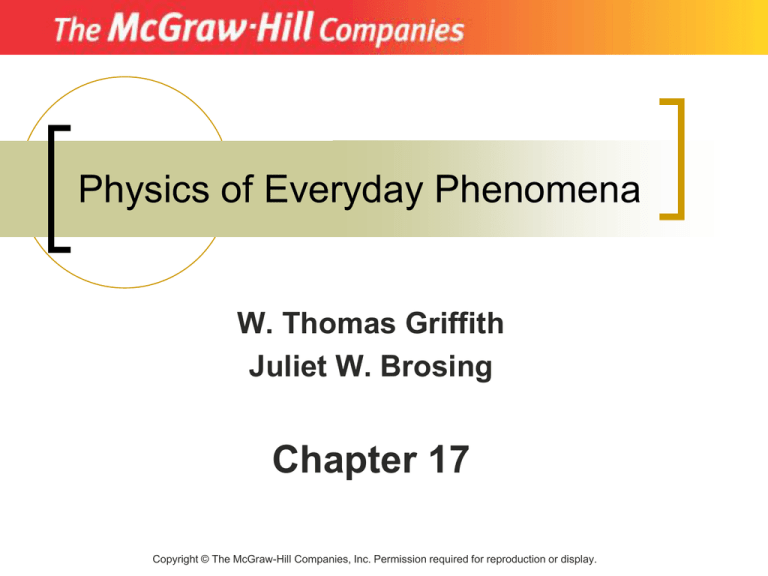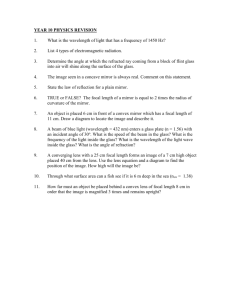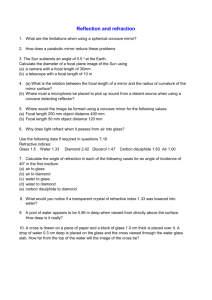Clickers - Galileo
advertisement

Physics of Everyday Phenomena W. Thomas Griffith Juliet W. Brosing Chapter 17 Copyright © The McGraw-Hill Companies, Inc. Permission required for reproduction or display. Question 17.1 The angle that a incident light ray makes with the surface normal A) is smaller than the angle that the reflected ray makes with the normal B) the same size as the angle that the reflected ray makes with the normal C) greater than the angle that the reflected ray makes with the normal Question 17.2 You would like to buy a full-length mirror which allows you to see yourself from head to toe. The minimum height of the mirror is A) half your height. B) two-thirds of your height. C) equal to your height. Question 17.3 When using rays to represent the direction of light, these are drawn A) perpendicular to the wavefronts B) parallel to the wavefronts C) so they have no relation to the wavefronts Question 17.4 A surface normal is A) A normal everyday surface, like a desk B) A line drawn parallel to a surface C) A line drawn perpendicular to a surface D) A line drawn 45° to a surface Question 17.5 The speed of light in vacuum is A) smaller than the speed of light in glass B) the same as the speed of light in glass C) greater than the speed of light in glass Question 17.6 The index of refraction,n, is calculated as A) the ratio of the speed of light in the material to that in a vacuum (n=v/c) B) the ratio of the speed of light in a vacuum to that in the material (n=c/v) C) the product of the speed of light in a vacuum to that in the material(n=vc) D) the square root of the speed of light in the material (n= ) v Question 17.7 A laser beam is incident upon a piece of glass as shown. Inside the glass, the laser beam will take path nair = 1.000, nglass = 1.50 A) 1 B) 2 C) 3 Question 17.8 In which case can total internal reflection occur? nwater = 1.333, nglass = 1.50, nair = 1.000 A) At the interface between glass and water, when traveling in glass. B) At the interface between glass and water, when traveling in water. C) At the interface between air and water, when traveling in air. D) At the interface between air and glass, when traveling in air. Question 17.9 The point where rays intersect when leaving the lens, if they were traveling parallel to the axis when they entered the lens, is called the A) aperture B) surface normal C) focal point D) vertex Question 17.10 The focal length of a converging lens is A) negative B) zero C) positive D) infinity Question 17.11 Which of the following light rays is drawn incorrectly? A) a B) b C) c D) d E) e Question 17.12 An object is located in front of a converging lens with focal length F as shown. The image can be described as A) upright, magnified, and real. B) upright, diminished, and virtual. C) inverted, diminished, and real. D) inverted, magnified, and virtual. Question 17.13 The focal length of a convex mirror is A) positive B) negative C) zero D) infinity Question 17.14 A concave mirror has a focal length F. An object that is placed in front of the mirror has an image that A) can be upright or inverted. B) is always upright. C) is always inverted. D) depends on the magnitude of F. Question 17.15 To save on electricity and eliminate heat in the kitchen, you would like to build a solar cooker. Which type of mirror would work best? A) convex B) concave C) planar Question 17.16 Your rearview mirror states "OBJECTS IN THIS MIRROR ARE CLOSER THAN THEY APPEAR." The mirror is A) convex. B) concave. C) planar. Question 17.17 If you hold a shiny spherical Christmas tree ornament at arm's length and look at your reflection, the image is A) upright and enlarged. B) upright and reduced. C) inverted and enlarged. D) inverted and reduced. Question 17.18 In people who are nearsighted the lens in their eye focuses the image in front of the retina. Do nearsighted people need glasses with converging lenses or diverging lenses? A) converging B) diverging C) depends on the person Question 17.19 The players on Survivor need to start a fire to cook their food. One team member is farsighted, another is nearsighted. Whose glasses should they use to focus sunlight on the tinder? A) The nearsighted person's. B) The farsighted person's. C) Either of them would work. Question 17.20 In order to use a simple magnifying glass, you want to place the object of interest A) at a distance greater than that of the focal point. B) between the magnifying glass and the eye. C) at a distance less than that of the focal point. Question 17.21 Given this schematic diagram of a defective eyeball, which of the lenses shown can correct for this defect? A) a B) b C) c D) d E) e Question 17.22 Hermione wears glasses that make her eyes look larger than they actually are. These glasses are A) for correcting nearsightedness. B) for correcting farsightedness. C) for cosmetic purposes only. Question 17.23 Suppose you take the eyepiece out of a microscope and replace it with an eyepiece having twice the focal length. The magnification of the microscope will A) double. B) halve. C) remain unchanged. D) quadruple. E) none of these. Answers to Chapter 17 1) 2) 3) 4) 5) 6) 7) 8) B A A C C B C A 9) 10) 11) 12) 13) 14) 15) 16) C C D C B A B A 17) 18) 19) 20) 21) 22) 23) D B B C A B B



